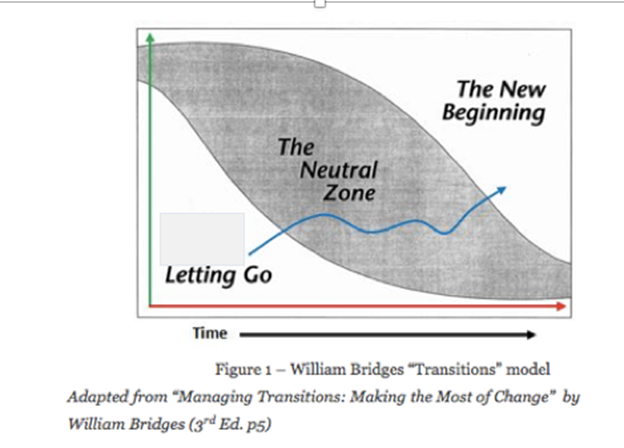Embracing New Beginnings: A Toolkit For Change and Transitions

As I transition to the start of a new academic year as a clinical cardiology fellow at the University of Iowa, I think of all the incoming residents and fellows across the country embarking on their new roles. Navigating transitions can be overwhelming and provoke a variety of emotions, ranging from excitement, happiness and curiosity to anxiety, and perhaps, even a feeling of longing and insecurity. I turn my thoughts to my family in India (who are beyond excited for my new professional journey) and to my mentors and colleagues who I will bid a bittersweet farewell. I relish the opportunity to form new friendships and take on the responsibilities of a cardiology fellow. In times of change, it is common to seek to establish new social connections, let go of old ties and forge new meaningful relationships.
In his New York Times bestseller "Life Is in the Transitions," author Bruce Feiler insightfully discusses transitions as being nonlinear, more often being zig zags or rollercoasters. The COVID-19 pandemic certainly confronted us in ways we could never have predicted and presented unprecedented challenges in navigating to a new normal, constantly learning to adapt and thrive. Williams Bridges, a transitions management consultant, famously described the model as the "Letting Go – Neutral Zone – New Beginning" process, showing how we as individuals may spend varied time periods in the different phases of transition before we feel comfortable on the other side and ready to embark on our new beginnings.
As I reflect on our changing environment, I would like to share a few coaching tips and tools that can help us understand the dynamics of transitions and thrive during these times.
1. Letting go with gratitude
It always helps to look back and appreciate how far we have come and to recognize the contributions and support of others, especially our family, mentors and colleagues.
Coaching Tip: Being specific when expressing gratitude helps. Reflect on how the specific actions of a person resulted in your success, consider the likely negative consequences if we hadn't received the help or support. These exercises can strengthen our practice of gratitude.
2. Awareness and acceptance of transitions
Being aware of the complex, nonlinear pattern of our transitions can help us be kind to ourselves and make ourselves available to those who are going through a similar path.
Coaching Tip: It is good to remember that we are all in this together. This provides opportunities for us to support others and bring meaning and purpose to our daily lives.
3. Identify priorities
Change often mediates pertinent insights on refocusing our perspectives, efforts and priorities. It provides the space to think about what we value the most.
Brian Dyson, the former CEO of Coca-Cola Enterprises, famously said:
"Imagine life as a game in which you are juggling five balls in the air. You name them – work, family, health, friends and spirit/soul – and you're keeping all of these in the air. You will soon understand that work is a rubber ball. If you drop it, it will bounce back. But the other four balls – family, health, friends and spirit – are made of glass. If you drop one of these, they will be irrevocably damaged or even shattered. They will never be the same."
Coaching Tip: The Wheel of Life is a great self-assessment tool that can help to define our immediate and long-term priorities and help us navigate balance in our busy lives. We must learn to prioritize our physical and mental health and relationships and contemplate life's purpose.
The exercise can be accessed here.
4. Transforming expectations to goals and growth
With new beginnings, it is natural to have expectations – of ourselves, our peers and our environment. Healthy expectations can serve as a source of motivation and give a sense of direction. In order to embrace new beginnings and derive tangible outcomes, we need to learn to transform our expectations into goals. By setting goals, we can commit ourselves and gain the power to convert our vision into our reality.
Coaching Tip: Goal setting is a purposeful, powerful skill that can be cultivated. Setting small, achievable, relevant goals enables us to accomplish bigger priorities. A useful goal-setting tool, the SMART goals (S – Specific, M – Measurable, A – Achievable, R – Relevant, T – Time-bound), offers a great read on this topic!
As the title of the book by Bruce Feiler reads: Life is in the transitions! I hope this article invites you to reflect and strive to embrace new beginnings with greater optimism, skill and purpose.
I would like to take this opportunity to thank the leadership and members of ACC FIT council for providing a platform to facilitate a dialogue on life coaching. I hope I have imparted that life coaching is a creative and collaborative process to grow and enhance our potential as individuals and as a community. I hope to further explore interactive life coaching experiences at the upcoming scientific meetings with American Society of Preventive Cardiology and American Heart Association and look forward to continued conversations.
ACC Members, discuss
this on Member Hub.
This content was developed independently from the content developed for ACC.org. This content was not reviewed by the American College of Cardiology (ACC) for medical accuracy and the content is provided on an "as is" basis. Inclusion on ACC.org does not constitute a guarantee or endorsement by the ACC and ACC makes no warranty that the content is accurate, complete or error-free. The content is not a substitute for personalized medical advice and is not intended to be used as the sole basis for making individualized medical or health-related decisions. Statements or opinions expressed in this content reflect the views of the authors and do not reflect the official policy of ACC.


